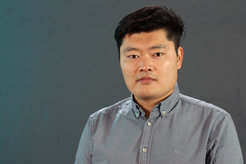Kai Zhang †
We mourn the passing of Prof. Kai Zhang. With him we lose a talented scientist, a passionated team member and a very good friend.

Kai Zhang was a polymer and materials chemist by training. From 2002 to 2007, he did his undergraduate study and master degree in chemistry at the University of Cologne in Germany. He completed his PhD by the end of 2010 in the group of Professor Bernd Tieke in Cologne, and partly in the group of Professor Peter Skabara at the University of Strathclyde, Glasgow, UK, working on novel conjugated polymers for photovoltaic applications. From 2011 to 2013, he worked as a postdoctoral researcher with Professor Markus Antonietti at the Max Planck Institute of Colloids and Interfaces in Potsdam, Germany. At the beginning of 2013, he joined the Department of Physical Chemistry of Polymers under Prof. Katharina Landfester at the MPI-P as a research group leader. His research activity was mainly focused on photoactive polymer materials and their applications in the fields of organic photoredox reactions, energy- and environmentally related catalysis, bio- and photocatalytic cascade reactions, etc.
Kai was associate editor of the journal Polymer International (Wiley). He held a Guest Professorship “la chaire TOTAL de la Fondation Ballard” at Pole Chimie, University of Montpellier, Montpellier, France. He was selected to the “Young Leaders in Science” by the Schering Foundation, Germany in 2016, and awarded with the Grants for outstanding young university teachers and professors of chemistry, German Chemical Industry Association (VCI). In 2018, he was selected as 2018 Emerging Investigator by Royal Chemical Society (RSC), in Materials Science (Journal of Materials Chemistry A). He also received several travel grants from the German Chemical Society (GDCh) and the Royal Society of Chemistry (RSC), UK. From 2018 on, he also was professor at Fudan University, China.
Research Interests
Inspired by nature photosynthesis, his research group aimed to design polymer materials as a new generation of heterogeneous photocatalysts to facilitate chemical reactions with the assistance of solar energy.
Polymer-based photocatalysts are promising candidates to resolve the disadvantages of classical homogenous photocatalytic systems as toxicity of metals, high cost, and stability issues due to photo-bleaching effects. Kai’s group used different methodologies featuring versatile photophysical and electronic properties by structural design on the molecular level. The diverse combination of organic electron donors or acceptors in π-conjugated polymer backbones allows fine control over light absorbance and the optical band gap to optimize energy transfer and thereby enhance photocatalytic efficiency. In the virtue of designability, polymer photocatalysts can be endowed with morphological and chemical traits for target-specific reactions, for example, organic photoredox reactions, energy- and environmentally related catalysis, bio- and photocatalytic cascade reactions, etc.


